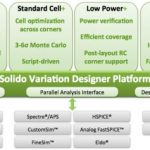Very often we talk about increasing design complexities and verification challenges of SoCs. With ever growing design sizes and multiple IPs on a single SoC, it’s a fact that SoC design has become heterogeneous, being developed by multiple teams, either in-house or outsourced. Considering economic advantage amid pressure … Read More
Tag: eda
A Programmable Electrical Rule Checker
IC designers involved with physical design are familiar with acronyms like DRC (Design Rule Check), LVS (Layout Versus Schematic) and DFM (Design For Manufacturing), but how would you go about checking for compliance with ESD (Electro Static Discharge) rules? You may be able to kludge something together with your DRC tool and… Read More
Hot Topic – CMOS Image Sensor Verification!
Mobile applications require CMOS image sensor devices that have a low signal-to-noise ratio (SNR), low power, small area, high resolution, high dynamic range, and high frame rate. CMOS image sensor imaging performance is noise limited requiring accurate noise analysis on the pixel array electronics and column readout circuitry.… Read More
Transient Noise Analysis (TNA)
Tanner EDA Applications Engineers see a broad range of technical challenges that our users are trying to overcome. Here’s one worth sharing – it deals with transient noise analysis (TNA) for a comparator design. The customer is a producer of advanced flow measurement devices for application in medicine and research. The designer… Read More
MOS-AK/GSA Munich Workshop
The MOS-AK/GSA Modeling Working Group, a global compact modeling standardization forum, completed its annual spring compact modeling workshop on April 11-12, 2013 at the Institute for Technical Electronics, TUM, Munich. The event received full sponsorship from leading industrial partners including MunEDA and Tanner EDA.… Read More
Challenges of 20nm IC Design
Designing at the 20nm node is harder than at 28nm, mostly because of the lithography and process variability challenges that in turn require changes to EDA tools and mask making. The attraction of 20nm design is realizing SoCs with 20 billion transistors. Saleem Haider from Synopsys spoke with me last week to review how Synopsys… Read More
Reduce Errors in Multi-threaded Designs
Many advanced algorithmic IPs are described in C++. We use this language because of its flexibility. Of course software algorithms are written to be executed on processors so they don’t solve all the issues of getting the algorithm implemented in hardware directly. This is not simply a high-level synthesis (HLS) issue. Usually… Read More
Using Virtual Platforms to Make IP Decisions
Most SoC designs these days consist largely, but not entirely, of purchased IP blocks. But there are lots of tradeoffs involved in selecting IP blocks, and since those tradeoffs change with process node, even decisions that seem “obvious” based on the last generation of the design, may not be so clear cut. Even if you… Read More
TSMC ♥ Solido
Process variation has been a top trending term since SemiWiki began as a result of the articles, wikis, and white papers posted on the Solido landing page. Last year Solido and TSMC did a webinar together, an article in EETimes, and Solido released a book on the subject. Process variation is a challenge today at 28nm and it gets worse… Read More
Mentor CEO Wally Rhines U2U Keynote
You will never meet a more approachable CEO in the semiconductor ecosystem than Dr. Walden C. Rhines. The first time I met Wally was way back when I blogged for food and he invited me over for lunch. Even better, a year or two later I was having dinner with a friend at the DBL Tree in San Jose. Wally was waiting for his flight home so he joined… Read More











